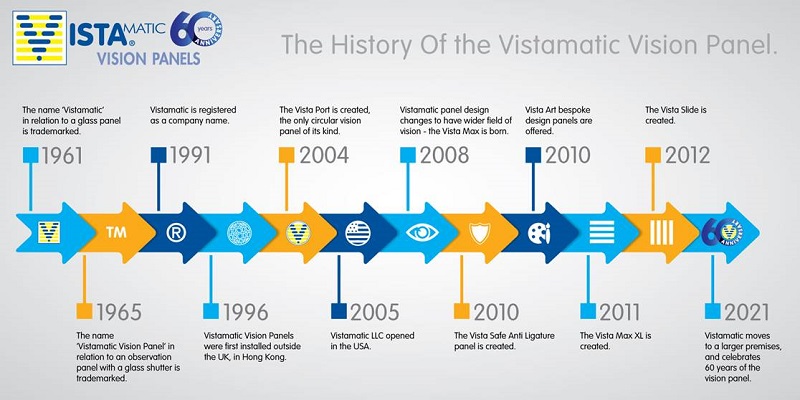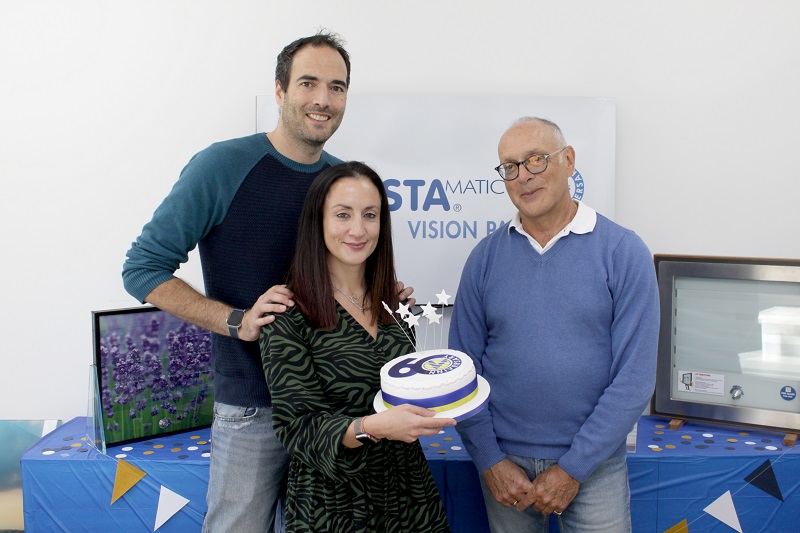The idea of creating a moveable panel that could produce an opaque surface was first developed by Steeles Glass in the early 1960s and was trademarked as a ‘Vistamatic’ panel in 1961.
However, it was not heavily promoted and remained largely untouched for a number of years.
In the early 1990s, Home Comfort Ltd purchased the glazing company and began developing the business and looking for new opportunities.
And one area they saw with serious potential was the health sector.
Showcasing the products, they began to generate interest, and the innovative privacy vision panels were at the forefront.
In 1991, Home Comforts made the decision to focus on the burgeoning market and set up Vistamatic as a business in its own right, with John Nerden taking over the running of the company in 1994.
Starting with a small team of only four employees, the company was manufacturing around 10-20 units a day.
Not many manufacturers offer a lifetime warranty, but we are proud of our longevity and the reliability of our installs is a major selling point
Using high-quality, durable components, the panels gained a reputation for reliability and ease of installation and quickly picked up orders from NHS trusts.
By 1995, the product began to garner interest from overseas, with Nerden and the team exhibiting at shows in South America, the Middle East, and Asia. And, in 1996, units were installed in Hong Kong, the first outside the UK.
From there the export business grew and Vistamatic founded a North American company, located in Florida.

Vistamatic has evolved over the years, now exporting to a number of overseas markets
A growing global presence
It now has both a factory and offices in the UK and the United States and employs more than 50 people globally.
Moving into the new millennium, the original vision panel continued to be the prominent choice for the healthcare market and, in 2010, Mark Nash, Nerden’s son-in-law, joined the company as a co-director.
Speaking to BBH, Nash explained: “The Vistamatic vision panel is low maintenance, very reliable, and easy to install.
“It’s inexpensive to buy in light of its longevity, and there are no extra mechanical parts, so it’s tailor made for healthcare.
“Even though it has been around for 60 years, the design was so strong we have not needed to make major changes within the product itself.
We are proud to already support green business principles and are committed to lower our footprint even further going forward
“We’d only adapted the CAM mechanism which turns and lifts the glass to a patented single-piece product.”
Nash, who has a background in sales, was tasked with helping market the products more widely and develop opportunities.
After extensive research and with essential feedback from NHS trusts, the Vistamatic team worked on improving on the original panel design.
The outcome was the Vista Max, which offers an enhanced viewing area with significantly-fewer blind spots – critical within mental health environments.
Shortly afterwards, the company launched the Vista Max XL, which dispensed with the need to install two individual panels into a door blank.
Both were exceptionally well received and have since become the industry standard.
Such is the company’s faith in its current products that it now offers a lifetime warranty on all units.
Nash said, “We can go into hospitals around the country and our products are still working years and years after they were installed.
“Not many manufacturers offer a lifetime warranty, but we are proud of our longevity and the reliability of our installs is a major selling point.”
While the vision panel, in its many guises, continues to be favoured among healthcare providers, Nash’s conversations with clients identified an issue, as well as a new opportunity.
Nash said: “Vistamatic is a fantastic product, but it has always been limited with size constraints. Once you go over a certain width and height, the middle panel takes a lot of force to raise and lower.
Looking to the future, we expect to see all our products continue to evolve into the next 60 years and aim to remain at the forefront of design technology, particularly for the NHS and wider healthcare sector
“Healthcare operators kept asking for bigger units, but with Vistamatic we couldn’t manufacture them, no matter how much we looked at the issue.”
So, in 2012, Nash and Nerden set up BetweenGlassBlinds, a new company which provides units with integral blinds rather than heavier glass inset panels.
Nash said: “BetweenGlassBlinds fits two different needs. The units can be manufactured at the large sizes clients want, but, also, there are many places where the environment needs to feel less institutional, yet keep the secure observation.

Directors, Mark and Samantha Nash and John Nerden celebrate the landmark anniversary
Broadening horizons
“BetweenGlassBlinds solves that problem. It’s contemporary and can be used to give a more residential feel to a project, but with similar benefits to Vistamatic.”
This has given the company a new inroad into other sectors, including leisure and education, as well as residential housing.
“Vistamatic is so connected with healthcare, and we realised that our integral blinds could be used in so many different scenarios, from schools to gyms to conservatories.
“As someone who saw my future career as running the company, I wanted to offer diversity in light of the changeable nature of NHS funding and I also wanted the company to have another string to its bow.
“It means we can attract other markets and it is further helping us in terms of expanding our exports.”
Vistamatic as a company isn’t resting on its laurels either.
In the past few years, in response to discussions with NHS trusts, it unveiled its Vista Safe Anti-Ligature model for use in higher security and mental health wards.
It’s also developed its bespoke designed Vista Art panels, which enable graphics to be printed onto the vision panels.
Even though it has been around for 60 years, the design was so strong we have not needed to make major changes within the product itself
This allows for a homelier aesthetic, as well as being ideal for dementia care environments.
The company also introduced a laterally-moving Vista Slide unit for larger placements, alongside a popular thumb-turn operating mechanism.
“Vistamatic has never been an off-the-shelf product,” explains Nash. “It has become more and more bespoke over the years.
“We will speak to trusts and architects to find out the specific environment the window is going into and then we will suggest whether the best option is an acoustic product, or a blackout product, or one with X-ray or laser protection.
A sustainable future
“We ensure that each unit is designed to exactly meet the requirements of the staff and the building it is placed in.”
And, as the product celebrates its 60th anniversary, the focus for the future is sustainability and continued innovation.
Nash said: “We are proud to already support green business principles and are committed to lower our footprint even further going forward.
“Our panels are easy to maintain as there is no external power and there is very little wastage in the production line, which helps it meet the NHS’s net-zero carbon emissions throughout its supply chain.
“Looking to the future, we expect to see all our products continue to evolve into the next 60 years and aim to remain at the forefront of design technology, particularly for the NHS and wider healthcare sector.
“The Vistamatic vision panel has long been a stalwart in the healthcare industry; the gold standard solution to enhancing visibility and safety within hospitals and we look forward to seeing what the next 60 years of Vistamatic will bring.”






